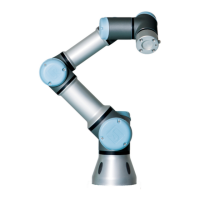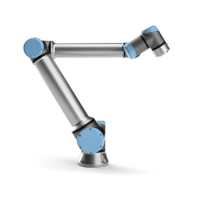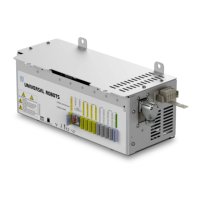2.4 Safety Modes
450 mm
200 mm
Figure 2.1: Certain areas of the workspace should receive attention regarding pinching hazards, due to the
physical properties of the robot arm. One area is defined for radial motions, when the wrist 1 joint is at a
distance of at least 450 mm from the base of the robot. The other area is within 200 mm of the base of the
robot, when moving in the tangential direction.
Using a plane to trigger Reduced mode: When the robot moves from the Reduced mode side of the
trigger plane, back to the Normal mode side, there is a 20mm area around the trigger plane where
both Normal and Reduced mode limits are allowed. It prevents the safety mode from flickering if
the robot is right at the limit.
Using an input to trigger Reduced mode: When an input is used (to either start or stop Reduced
mode), up to 500ms can elapse before the new mode limit values are applied. This could happen
either when changing Reduced mode to Normal mode OR changing Normal mode to Reduced
mode. It allows the robot to adapt e.g. the speed to the new safety limits.
Recovery Mode When a safety limit is violated, the safety system must be restarted. If the system
is outside a safety limit at start-up (e.g. outside a joint position limit), the special Recovery mode is
entered. In Recovery mode it is not possible to run programs for the robot, but the robot arm can
be manually moved back within limits either by using Freedrive mode or by using the Move tab in
PolyScope (see part II “PolyScope Manual”). The safety limits of Recovery mode are:
Limiting Safety Function Limit
Joint speed 30
◦
/s
TCP speed 250
mm
/s
TCP force 100 N
Momentum 10
kg m
/s
Power 80 W
The safety system issues a Stop Category 0 if a violation of these limits appears.
UR3/CB3 I-16 Version 3.10
Copyright © 2009–2019 by Universal Robots A/S. All rights reserved.

